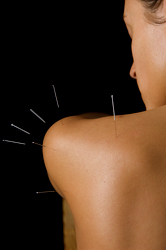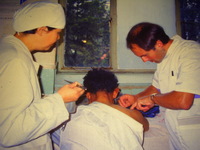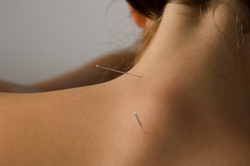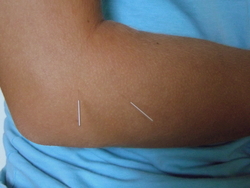Introduction
 Musculoskeletal conditions encompass a very wide array of problems, but for simplicity I shall exclude under this category, both injuries and arthritis; for help with them, please click on their specific headings. Under the musculoskeletal heading, I am going to give you an introduction to how acupuncture approaches conditions as diverse as frozen shoulder, stiff neck, tight shoulders, trapped nerves, carpal tunnel syndrome, knee pain, foot pain, fibromyalgia and other chronic pain conditions.
Musculoskeletal conditions encompass a very wide array of problems, but for simplicity I shall exclude under this category, both injuries and arthritis; for help with them, please click on their specific headings. Under the musculoskeletal heading, I am going to give you an introduction to how acupuncture approaches conditions as diverse as frozen shoulder, stiff neck, tight shoulders, trapped nerves, carpal tunnel syndrome, knee pain, foot pain, fibromyalgia and other chronic pain conditions.
A large review funded by the National Institute for Health & Care Research in 2017, concluded that acupuncture is better than usual care for pain from musculoskeletal conditions.
Your First Consultation
In our first consultation, I need to establish when the problem began, whether you feel it was triggered by a particular event, or whether it has crept on gradually. Then there are some other things for you to think about. Do you feel pain all of the time, or only on certain movements? Is your range of movement restricted, and if so, how eg. a frozen shoulder might be preventing you from reaching into a back pocket or brushing your hair? Is the pain sharp or shooting, or does it feel more dull and heavy? Have you found it responds to movement, rest or warmth? Does the pain spread some distance from where you feel the focus of the problem lies eg. pain which radiates from your shoulder to your elbow or beyond?
Next I will gather information on your health and wellbeing more generally, and note any other medical conditions which you have, or have had, in the past. We will move on to a thorough physical examination of the affected area and its surroundings, including assessing your range of movement and checking for tender areas. I can then give you your first treatment, aimed not only at helping the problem directly, but also at assisting with any subtle underlying imbalances which may have been perpetuating it: even stress may be one such factor.
Treatment

My treatments for musculoskeletal problems are likely to involve a combination of massage and acupuncture, with exercises for you to perform at home. Generally, the longer a condition has persisted, or the more severe it is, the more treatment will be required. Some change is usually experienced after four or five treatments, but fairly recent problems treated early, can respond more quickly. I will usually suggest an initial number of sessions, after which we will review progress.
Do not worry if I have not listed your specific musculoskeletal problem (there exist a great many), or if you have not to date had a clear diagnosis. You are always welcome to telephone to discuss it.
Below you can read the results of some of the research which has been undertaken into acupuncture for musculoskeletal problems. The trials vary in quality, but systematic reviews and randomised controlled trials are generally considered to provide the highest quality evidence. If you would like to read more about evidence quality, I would refer you to the British Acupuncture Council’s description of the evidence pyramid.

 Acupuncture works for fibromyalgia, with an international team of authors concluding it showed a significant effect in the management of the condition by reducing pain and depression, and enhancing quality of life. The team was drawn from Saudi Arabia, Spain, the USA, Turkey, Taiwan, Italy and Egypt. Together they analysed the results from 23 randomised controlled trials, covering over 1400 patients.
Acupuncture works for fibromyalgia, with an international team of authors concluding it showed a significant effect in the management of the condition by reducing pain and depression, and enhancing quality of life. The team was drawn from Saudi Arabia, Spain, the USA, Turkey, Taiwan, Italy and Egypt. Together they analysed the results from 23 randomised controlled trials, covering over 1400 patients. American researchers report that electro-acupuncture helps fibromyalgia pain, by altering the way the brain’s amygdala connects with its representation of the body. A total of 76 fibromyalgia patients were randomised to receive either electro-acupuncture or mock laser acupuncture, twice a week for a total of eight treatments. Functional brain network connectivity was assessed using resting state functional magnetic resonance imaging (MRI), and proton magnetic resonance spectroscopy, before and after treatment.
American researchers report that electro-acupuncture helps fibromyalgia pain, by altering the way the brain’s amygdala connects with its representation of the body. A total of 76 fibromyalgia patients were randomised to receive either electro-acupuncture or mock laser acupuncture, twice a week for a total of eight treatments. Functional brain network connectivity was assessed using resting state functional magnetic resonance imaging (MRI), and proton magnetic resonance spectroscopy, before and after treatment. An Italian team at the University of Verona, researching acupuncture and fibromyalgia, have shown it represents an effective treatment option. They also studied the effectiveness of a group of nutritional supplements.
An Italian team at the University of Verona, researching acupuncture and fibromyalgia, have shown it represents an effective treatment option. They also studied the effectiveness of a group of nutritional supplements.  An international team has shown that acupuncture helps tennis elbow, and can improve both pain and function. A total of 96 patients, aged 18 to 80, with chronic unilateral tennis elbow, were randomised to receive either true acupuncture or a sham laser treatment as a control. Both groups received three sessions per week for three weeks, at centres in Italy, Australia, Hong Kong and China.
An international team has shown that acupuncture helps tennis elbow, and can improve both pain and function. A total of 96 patients, aged 18 to 80, with chronic unilateral tennis elbow, were randomised to receive either true acupuncture or a sham laser treatment as a control. Both groups received three sessions per week for three weeks, at centres in Italy, Australia, Hong Kong and China.